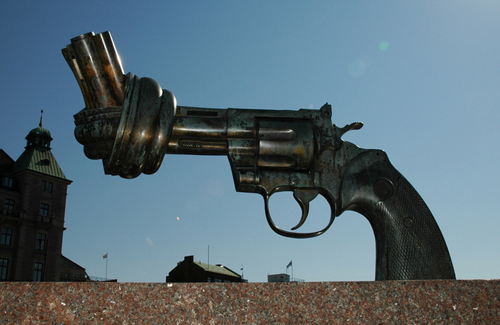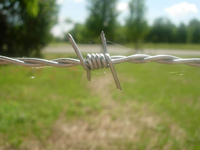Risk Assessment Evaluation & Security: Risk Management in the Prevention of School Shootings:
Preventing Homicide and Suicide in Our Schools
Posted on May 29, 2020
There have been many school shootings dating back to at least 1974. Usually the shootings involve a fourteen to seventeen-year old male who has access to a semi-automatic handgun. Several of the most recent school shootings include Columbine High School in Littleton, Colorado, on April 20, 1999, and the shootings at Virginia Tech in 2007.
 More American children are killed by firearms than all natural causes combined. More people die in car accidents than from guns, but the numbers are closer than one may think. Seven states in 2007 had more teenage deaths from firearms than from traffic-related accidents. One of our major problems in America is that male youth say it’s obtaining a gun is easy. More than 50 percent of male youth say this. Most say they can get a gun within 24 hours. Among students who said they carry a gun, 53 percent said they obtained the gun from their home or family, and 37 percent obtained the gun “off the street.”
More American children are killed by firearms than all natural causes combined. More people die in car accidents than from guns, but the numbers are closer than one may think. Seven states in 2007 had more teenage deaths from firearms than from traffic-related accidents. One of our major problems in America is that male youth say it’s obtaining a gun is easy. More than 50 percent of male youth say this. Most say they can get a gun within 24 hours. Among students who said they carry a gun, 53 percent said they obtained the gun from their home or family, and 37 percent obtained the gun “off the street.”
Causes of School Shooting Tragedies
After a review of records that has included hundreds of hours of interviewing, listening, and reading about teenagers who resort to violence, it appears these boys have ultimately come to the conclusion that they’ve “run out of options” and the only way to solve problems is with violence. We forget these shooters are often still children. They’re impressionable, impulsive, and often despondent. They’ve often been affected by the intolerance of differences between students.
These children can be extremely emotional and impulsive, not completely in touch with reality, or unable to tell the difference between fantasy and reality. Despite careful parental training of a young man, little is done to prepare him for being “dumped by his girlfriend” or picked on by someone much larger and stronger than he is. All the gun safety training in the world may not stop him from grabbing that gun and doing what he feels he has to do. Adolescents who feel weak and defenseless or who have a history of being bullied or picked-on are at high risk for episodic violence.
Although unintentional injury in automobile accidents remains the leading cause of death, gun death rates among children and youth due to homicide, suicide, and unintentional shooting are far higher in the U.S. than other countries. The number of gun deaths among children hit a historic high of 5,833 in 1994. An estimated fifty-eight percent of firearm deaths among children and youth were homicides.
In the case of school shootings, the public questions, “What pushes a young man over the line? How does a young man get to the point where he cares so little about his life and future, as well as the lives and futures of others? Why does he unexpectedly be-come destructive and callous in regards to reckless and destructive behavior that too often involves major injury and homicide? Is there a way to determine how likely it is that he will resort to such behavior before it occurs?”
High school is often a terrifying experience for many teenagers. They see the casual cruelty of “the popular kids” making it hell for them. Every high school has a small percentage of kids who are ostracized, humiliated, and assaulted periodically throughout the school year. As long as some kids go out of their way to make high school hell for others, there are always going to be kids who crack under the strain. And, not all kids who crack are going to go off quietly by themselves. Shooters are kids who feel like outcasts and may venomously loathe their high school and fellow students. They detest the popular kids, and the administration and group of teachers who, in their minds, “kowtow” to the popular kids. Every day of being teased and picked on and being pushed up against lockers, creates a general feeling of fear in school. One student interviewed stated, “You either respond by having fear or you take action and have hate.”
Defining Risk, Risk Management and Security Risk
Risk is a concept that denotes a potential negative impact to some characteristic of value that may arise from a future event, or we can say that "Risks are events or conditions that may occur, and whose occurrence, if it does take place, has a harmful or negative effect...."
Risk communication and risk perception are essential factors for all human decision making.
Risk assessment and management: Because planned actions are subject to large cost and benefit risks, proper risk assessment and risk management for such actions are crucial to making them successful (Flyvbjerg 2006).
Since risk assessment and management is essential in security management, both are tightly related...." [From Wikipedia, the free encyclopedia]
Role of Risk Assessment Evaluation
School district administrators around the country have developed a response to the threat of violence in the school setting. These threats often are expressed to other students through direct verbal communication, e-mail, MySpace, or text messaging. When a report of a threat is revealed to school authorities, it must be taken very seriously. Part of the evaluation of risk is done through a risk assessment examination, including thorough and extensive interviewing of parents, guardians and the student.
Generally, most clinical psychologists will administer a battery of psychological tests specific to the adolescent. These include the Minnesota Multiphasic Personality Inventory--Adolescent (MMPI-A) and the Millon Adolescent Clinical Inventory (MACI). The psychologist looks carefully for risk factors including reported family problems, expressed and suppressed/repressed significant anger, access to guns or weapons, history of mental illness and treatment, paranoia and psychosis, and current alcohol or psychoactive/illicit drug abuse. The level of isolation from family and peer groups is also a significant factor assessing risk. The history of conflicts resorting to the use of aggression or violence is likely one of the best predictors of the level of risk for future violence.
Often children who have threatened violence are not a significant risk to act out violence. This threat may be a cry for help, or an event that can be freed from a confused or ambiguous interpretation with a risk assessment evaluation.
We also try to understand the circumstances of the violent acts--when they occurred, who was involved, and did the behavior involve substance abuse?
We can ask the person being assessed to discuss the effect of the threats or the violence on the victim, in order to understand the level of remorse or empathy.
We also look at whether the adolescent reports history of feelings and thoughts including:
-
Uncontrollable rage
-
Thoughts of hurting others
-
Fantasies of revenge
-
Have there been previous fights?
-
Have there been previous arrests for fighting or violent behavior?
-
Often, after a threat of violence, brief psychotherapy lasting three to six months is recommended. This includes some areas of skill building that the therapist can focus on in an individual or a group psychotherapy setting. This also assures the school and the parents that a therapist’s vigilant eye will follow their student for some time, until adjustments are made, to decrease the chance of further incidents.
Assessment of Risk for School Shootings
When a psychologist evaluates an adolescent for risk of violence in the school setting, many factors are involved. Determining who is at high risk is a difficult process. There is no exact profile of the “school shooter.” Research, however, reveals that past history of school violence has been committed by three different groups.
Group number one: A student who is deemed mentally ill with some psychosis and/or delusions.
Group two: This group is seen as an “anti-social” group. Two-thirds of them have a long history of delinquent and disruptive behavior. They tend to be aggressive and impulsive. They have been described as dishonest and often tested out at below average intelligence level. Often they come from “disadvantaged and dysfunctional” homes.
Group three: These students are often seen as more “normal,” but careful assessment and testing reveals underlying emotional disturbance. These adolescents are often highly conflicted and have been alienated from their peer group. They present as angry with significant symptoms of depression. They tend to be intelligent and capable, but are usually seen as underachievers. They have a strong sense of having been mistreated and treated unfairly. They have been, and are, very sensitive to bullying and report a history of being teased. They tend to think about perceived injustices repeatedly, visualizing them over and over repeatedly for an extended period.
The psychologist conducts an extensive psychological interview and administers a battery of psychological profile testing. One goal is to rule out any mental illness. The interview focuses particularly on history of violent behavior and delinquency. Questions are asked regarding history and current suicidal or homicidal ideation or thought. The interview searches for any anti-social behavior or signs that the adolescent is “emotionally troubled” or has a history of being violated and picked on. Another important feature is determining the level of family and environmental support.
Suicide Risk Assessment
Suicide is the second leading cause of firearm deaths accounting for 33% of the deaths in 1998. The presence of a gun in the home increases the risk of suicide five-fold.
Many adolescents fantasize being in the spotlight. A teenager’s suicide note often looks for notoriety. The request is that is gets printed in big bold letters on the front of the local newspaper because, “It’s something every single one of you should read. You made my life miserable. You raised your kids to all want the same, and hate everyone who dares to be a little different. Maybe your kids did, but me and my friends chose not to. You didn’t understand. You have attacked and tormented us for years. You tried to make me conform to your narrow minded expectations of how we were supposed to dress and act.”
One suicide note read: “I could have gone and offed myself quietly, but that would have been an even bigger waste. When I go this way, taking people who have made my life miserable with me, it will send a message.”
The attitudes and thought processes of school shooters have been explored. The sense is there is significant suppressed anger. Suicide letters have often said, “Screw you. Screw all of you. I hope this letter is like a knife in your hearts. You ruined my life. All I’ve done now is pay you back in kind.”
The teenager’s state of mind is one that he believes he’ll never ever be happy. Life will hurt. There will be more bad than good. What’s the point of living? They believe if they go away, and take others who made their life miserable with them, it may send a message. Maybe then something will change and somewhere, somehow, other kids will be treated ultimately better in the future and find a reason to live.
Prevention of School Shootings
Studies of recent cases of shooters in schools have generally shown signs of clinical depression and other psychological problems. Sometimes severe family problems are the root of much of the emotional instability. Many of these teenage boys feel there have been an incessant number of injustices and it is up to them to make things even.
Recommendations for treatment for kids who have threatened violence include: 1) they need to learn how to deal with another without always becoming violent. Conflicts can be resolved without fights, and 2) they need to develop skills to deal with the huge pressures in adolescence, with healthy ways to “blow off steam” other than fighting.
Like all other animals, we were born with instincts and a genetic blueprint of what we must do to survive. However, humans possess the potential to learn civilized thinking and reasoning skills. We are supposed to learn to suppress our animal instincts in the world in order to fit into society around us. Part of the process of adolescent development is learning to suppress and repress aggressive and sexual impulses.
Kids have been getting into fights and picking on one another for ages. There is a great deal of suggestion and imitation. Violent movies, or television and video games, contribute to adolescents committing violent acts. The average 12-year old has seen more than 7,000 murders on television alone. Though violent movies, music, and video games are popular in many countries, unlike the United States most do not allow citizens to own handguns.
The availability of guns can affect the emotional decisions of teens. Many of the tragedies in our recent history didn’t have to happen. Guns and violence are deeply ingrained in our culture.
Parents, teachers, and other adults should be vigilant in looking for ways to reach out to young people. There is a common thread in the disappointments and isolation students have experienced when they lose the sense of place, loss of a parental figure, or loss of a girlfriend. What can we do to prevent more horrible tragedies? School shootings are a tale of what is happening all around our country. In the world of schools, guns and violence will forever change a place some students once called home. School programs designed to decrease bullying and teach anger management skills and methods for handling strong and upsetting emotions seem to offer the greatest hope for a less violent future.
Other Common Uses for the Risk Assessment Evaluation
"Risk Assessments" are requested in many situations and circumstances. If an employee has threatened harm or violence the employee assistance program or human relations department may require this examination before allowing them back on the job site.
Judges and probation officers often require psychological evaluation with special focus on "Risk Assessment" or “Risk Analysis” when there has been a previous charge of domestic violence, stalking, obstruction of justice, or assault. Although there is no battery of psychological tests or interview that can accurately predict a future act of violence with total certainty, there are some predictors which evaluators rely upon. These include underlying aggressiveness, a history of impulsivity, violence, and use of alcohol or other psychoactive drugs that tend to overcome psycho-logical inhibition.
Dr. David Dixon is a licensed clinical psychologist who has maintained a clinical practice in Seattle and Bellevue, Washington since 1983. He has ten years of experience conducting forensic exams and testifying as an expert witness in courtroom testimony, primarily in the greater Seattle, King County, WA, and Washington State area. He can be reached at (425) 454-8200.
This document is Copyrighted© by CounselingSeattle LLC, and may not be reproduced, in whole or in part without crediting the author, source and site name. All rights reserved.
Defining Risk and Risk Management and Security Risk
Risk is a concept that denotes a potential negative impact to some characteristic of value that may arise from a future event, or we can say that "Risks are events or conditions that may occur, and whose occurrence, if it does take place, has a harmful or negative effect...."
Risk communication and risk perception are essential factors for all human decision making.
Risk assessment and management: Because planned actions are subject to large cost and benefit risks, proper risk assessment and risk management for such actions are crucial to making them successful (Flyvbjerg 2006).
Since risk assessment and management is essential in security management, both are tightly related...."
[From Wikipedia, the free encyclopedia]
SEE ALSO:
More Mental Health Articles
Sexual Bias Articles
Race Relations Articles
How Drugs and Alcohol Affect the Brain and Body
WA. Counselor Directory: find a therapist near you
How helpful is this web page to you?
(and how can we can improve this page for you?)
not helpful
very helpful
Other Articles
From Drug Addict & Alcoholic to Entrepreneur:
A Story of Recovered Hope
The first-ever AA meeting I went to was in prison, and I didn’t speak. I didn’t stand up, didn’t say my name, and certainly didn’t tell my story. I did one thing though - I listened.... read more
Telemedicine is here to stay
It’s hard to imagine that the devastating pandemic we’re living through could possibly have a silver lining, but I think I’ve found one: telemedicine. Traditionally, health care has bee... read more
Affairs: Boundaries and Respect?
I’ve been thinking about affairs lately, seeing how devastating and destructive they are to a marriage and wondering why they happen. I consider myself knowledgeable about some subjects like eati... read more
Forensic Psychological Evaluation
Forensic psychology is a clinical psychology specialty which intertwines the law with two types of professional services: (1) psychological evaluation and assessment to assist the defense or prosecution... read more




